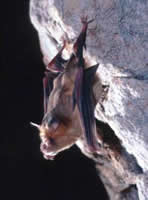Orange leaf-nosed bat

Common name: orange leaf-nosed bat
Scientific name: Rhinonicteris aurantia
Family: Hipposideridae (leaf-nosed bats)
Conservation status: This species is listed as Vulnerable in Queensland (Nature Conservation Act 1992).
Description: As its name indicates, the orange leaf-nosed bat has mostly bright orange fur with brown tips, although brown, yellow, or white fur (and skin) occurs less frequently. It has a nose-leaf consisting of flaps and lobes of skin forming complex structures around the nostrils, and weighs 6.5-11.2g.
Habitat and distribution
The orange leaf-nosed bat is found across the top end of Australia, from the Kimberley to north-west Queensland, and has an isolated population in the Pilbara region of Western Australia. The eastern edge of its distribution extends into north-western Queensland, with colonies near Camooweal and at Lawn Hill Gorge.
It is the only member of the genus Rhinonicteris, and is endemic to Australia. Orange leaf-nosed-bats in the Pilbara are treated as a separate form to those from the Kimberley, Northern Territory and Queensland.
The orange leaf-nosed bat forages in a range of habitats including grassland, open woodland, savannah woodland, and spinifex covered hills.
It roosts by day in caves and mines with a narrow band of high temperature and humidity (28-32ºC and 85-100% humidity). This narrow range may limit their distribution. In their roosts, the bats hang from the ceilings or against the walls, with a spacing of 10-15 cm between individuals. Orange leaf-nosed bats are very sensitive to human disturbance to their roosts and will quickly fly away from an intruder to deeper parts of the cave.
Life history and behaviour
As with most micro bats, the orange leaf-nosed bat is nocturnal. They exit the cave or mine roost in pairs, flying rapidly in a zigzag pattern about one metre above the ground. This behaviour may serve to reduce the risk of predation from ghost bats, which often occur in the same roosts. The flight of orange leaf-nosed bats becomes less erratic the further they move away from their roost.
Orange leaf-nosed bats forage on the wing, mostly for moths and beetles, but also for termites, flies, wasps, cockroaches, ants and lacewings. They may hunt in continual flight periods of up to six hours.
Threatening processes
The known threats to orange leaf-nosed bats are the destruction and disturbance of roosts from human visitation to caves, mining activities, and the collapse or flooding of ageing mine roosts. Inappropriate fire regimes is a potential threat.
Recovery actions
- Prevent further disturbance to roost sites from mining activities, unnecessary human visits to roosts, and the reinforcement of ageing sections of mine roosts.
- Monitor colonies in mines to detect any fluctuations in populations.
- Survey within the known distribution of the orange leaf-nosed bat to locate additional roosts.
Related information
Churchill, S. 2009. Australian Bats (second edition), Allen and Unwin, Sydney.
Milne Damian J., Burwell Chris J., Pavey Chris R. 2016. ‘Dietary composition of insectivorous bats of the Top End of Australia’. Australian Mammalogy 38: 213-220.
Van Dyck, S and Strahan, R (Eds.). 2008. The Mammals of Australia (third edition), New Holland Publishers, Sydney.
Woinarski, J, Burbidge, A and Harrison, P. 2014. The Action Plan for Australian Mammals 2012, CSIRO Publishing, Collingwood.


